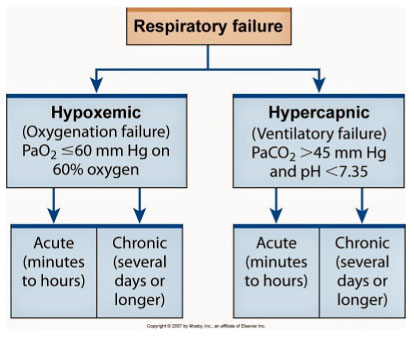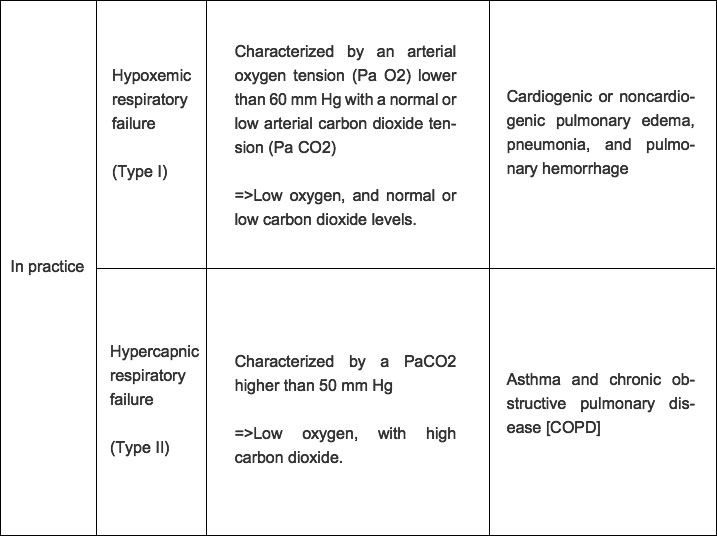Respiratory Failure
Respiratory failure is a disease of the lungs. It is inadequate gas exchange by the respiratory system, with the result that levels of arterial oxygen, carbon dioxide or both cannot be maintained within their normal ranges.
In practice, it diveides into Type I (Hypoxemic respiratory failure) and Type II ( Hypercapnic respiratory failure);
In clinical,it clarified as Acute Respiratory Failure and chronic Acute Respiratory Failure.


Type I respiratory failure occurs because of damage to lung tissue. This lung damage prevents adequate oxygenation of the blood (hypoxaemia);however, the remaining normal lung is still sufficient to excrete the carbon dioxide being produced by tissue metabolism. This is possible because less functioning lung tissue is required for carbon dioxide excretion than is needed for oxygenation of the blood.
Type II respiratory failure is also known as ‘ventilatory failure’.It occurs when alveolar ventilation is insufficient to excrete the carbon dioxide being produced.Inadequate ventilation is due to reduced ventilatory effort, or inability to overcome increased resistance to ventilation – it affects the lung as a whole, and thus carbon dioxide accumulates. Complications include: damage to vital organs due to hypoxaemia, CNS depression due to increased carbon dioxide levels, respiratory acidosis (carbon dioxide retention). This is ultimately fatal unless treated. Complications due to treatment may also occur.
Respiratory failure is accompanied by a number of symptomsincluding:
Bluish coloration of the lips or fingernails
Confusion or loss of consciousness
Fainting or change in level of consciousness or lethargy
Fatigue
Irregular heart rate (arrhythmia)
Rapid breathing (tachypnea) or shortness of breath
Serious symptoms that might indicate a life-threatening condition
One of the main goals of treating respiratory failure is to get oxygen to your lungs and other organs and remove carbon dioxide from your body. Another goal is to treat the underlying cause of the condition.
Multiple options are available for the treatment of respiratory failure. Examples include:
Antibiotics for respiratory infections
Bilevel positive airway pressure (BiPAP)
Bronchodilators, including anticholinergics, such as tiotropium (Spiriva), or beta agonists, such as albuterol (Proventil)
Continuous positive airway pressure (CPAP)
Inhaled steroid medications to decrease inflammation
Lung transplant, in rare cases
Mechanical ventilation, if oxygen therapy if not sufficient to increase blood oxygen levels
Oxygen therapy to increase blood oxygen levels
Tracheostomy, a hole made in the front of the neck to help you breathe
Any Questions when you use LoveGo POC, kindly contact us



